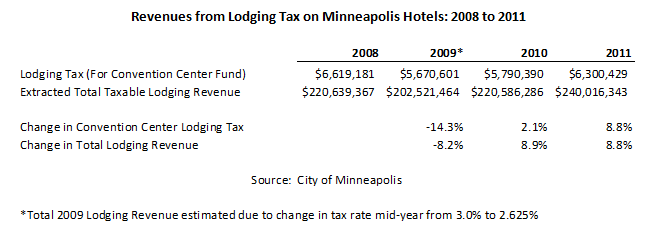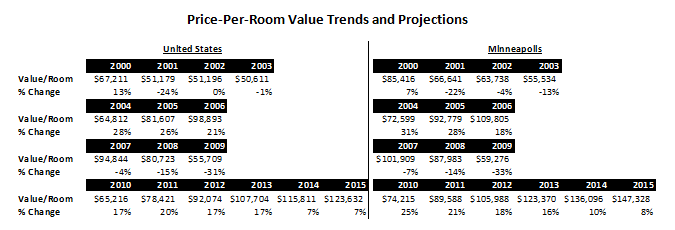
Over the past several decades the “City of Lakes” has become a fertile plain for business, quality of life, and tourism. Minneapolis is home to eight Fortune 500 companies, including giants like United Healthcare, Target, U.S. Bancorp, Medtronic, General Mills, Ameriprise Financial, and Xcel Energy. Like other local industries, the vitality of hotels in Greater Minneapolis stands on the pillars of a diverse and resilient economy, an efficient transportation infrastructure, affordable housing, and above-average employment levels. Below we look at major developments in Minneapolis that are relevant to hotel stakeholders.
Unemployment and Office Vacancy
The Minneapolis-St. Paul-Bloomington metropolitan area consistently achieves one of the lowest unemployment rates among metropolitan areas with populations of one million or more. 1 Minneapolis has gained thousands of new jobs over the last year; Target alone grew its local workforce by over 10,000 by moving its target.com operations in-house. Forbes named Minneapolis the “Best City for Finding Employment” in 2011, based chiefly on the area’s multifaceted economy and low cost of living. The magazine also recognized Minneapolis as one of the ”Top Twenty Best Paying Cities for Women” in 2012, and the city ranks among CareerBuilder’s “Top 15 Cities for Recent College Grads.”
Year-end office market vacancy in the Twin Cities fell in 2011, following a four-year trend of increase. The Greater Minneapolis office market also posted positive absorption in 2011. Overall office vacancy is expected to continue to shrink in 2012 as employment levels rise, though rental rates for the market will likely remain stagnant.2
Major Twin Cities Developments
The Mall of America, the nation's most visited shopping complex, draws 40 million people annually, around 16 million of whom are classified as tourists. In May of 2012, Ryan Companies was selected to develop a $200-million expansion at the mall that is expected to include a new luxury hotel, 125,000 square feet of retail space, a Mayo Clinic office building, and additional parking facilities. The 500-room, $137.5-million Radisson Blu at Mall of America is currently under construction and is anticipated to open in early 2013. This will be the largest hotel to enter the metro area since the opening of the Hilton Minneapolis in 1992. There are expectations of additional hotels to be developed near Minneapolis-St. Paul International Airport and the Mall of America; however, brands and room counts have not yet been determined.

Rendering of Radisson Blu at Mall of America [courtesy of Mortenson Construction]
A light-rail line to connect Downtown Minneapolis with Downtown St. Paul is currently under construction, with completion expected in 2014. In March of 2012, construction began on a light-rail line that will connect Ramsey to the Northstar Commuter Rail Line and provide convenient access to Downtown Minneapolis. This addition is anticipated to be complete by mid-November of 2012. In September of 2011, preliminary approval was granted through the Federal Transit Administration to begin plans for the region’s third light-rail project, which would connect Downtown Minneapolis to cities such as Eden Prairie, Minnetonka, Hopkins, and St. Louis Park. If funding comes through, this leg should be completed in 2017/18.
Performance Trends for Local Hotels
The Greater Minneapolis area’s big-league employers, world-class arts culture, and professional sports franchises generate significant demand, helping area hotels achieve a citywide occupancy in the mid-60 to low-70% range over most of the last ten years. Market-wide occupancy decreased in 2008, and an influx of new supply mid-year 2008 and early 2009, combined with fallout from the Great Recession, brought occupancy to an historic low in 2009. Occupancy rebounded in 2010 and continued to gain momentum through 2011 and the year-to-date period, a strong sign of resilience in the market. Average rate recovery became evident mid-year 2010, and the ramping up of new supply, which had to climb up from the recent economic gulf, allowed for strong rate growth in 2011 and year-to-date 2012.
Healthy business activity, visitation, and group demand prior to the recession’s entrenchment in 2008 spurred the development of more than 1,900 hotel guestrooms over a five-year period. The Hotel Ivy, W Hotel, Westin, Hotel Minneapolis, aloft, and Hilton Garden Inn opened in Downtown, joined by other large full-service hotels in the metro area, including the Westin Edina Galleria, Hilton Bloomington, Embassy Suites Brooklyn Park, and Sheraton St. Paul Woodbury.
One indication of the revitalization of the local hotel industry comes from lodging tax revenues over the past several years. The following table illustrates the trend in lodging tax collections for the Convention Center Special Revenue Fund since 2008, including the strong growth realized in 2010 and 2011.

While there have been only a handful of hotel transactions in the Minneapolis-St. Paul area over the last two years, the market remains attractive to potential buyers, largely because the multitude of demand generators translates into a lower risk for hotel investments. The following graph illustrates historical and projected changes in per-room hotel values for Greater Minneapolis versus the U.S. as a whole.3

The HVS/STR Hotel Valuation Index (HVI), from which the data above are drawn, tracks hotel performance, sales transactions, and hotel values in 66 major metropolitan hotel markets across the U.S. Between 2006 and 2009, Minneapolis hotel values declined by approximately 46%, compared with 44% for the nation. In 2010, however, given the recovery in occupancy and rate, the values of Minneapolis hotels increased at a level significantly above that of the nation. Based on the market’s current pace of recovery, hotel values in the Minneapolis market are anticipated to exceed pre-recession levels by 2013.
Conclusion
A fall in unemployment combined with a rise in office absorption over the past year has given the Greater Minneapolis market a firmer foothold in the march toward economic recovery. Despite the entrance of several new luxury hotels during the recent recession, market-wide occupancy has shown strong improvement; average rate growth is less pronounced, but is beginning to venture into positive territory. Given current demand trends and anticipated supply additions in the market, a full recovery will continue to take time. Still, Minneapolis' location, economic diversity, and demand-generating giants, such as the Mall of America, should give new and existing hotels traction over the long term.

What a great article on the heels of a terrific HVS Regional Summit in Minneapolis! These types of articles and networking events will solidify you as the go-to expert for the Minnesota region...way to go!
Excellent report. The best that I've seen. Would you have a current Minneapolis Hotel Market Report that you could send to me? Thank you.
Thank you very much for your feedback. An updated report will be available in August/September of 2014. Should you need any assistance in the mean time, my email is [email protected] and my direct line is 303-588-6558.